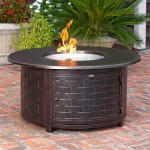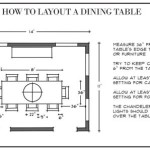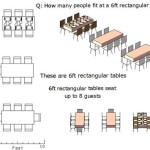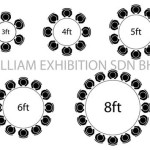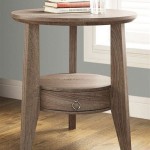Choosing the Right Size Round Rug for Your Table and 4 Chairs
Selecting the appropriate size rug for a dining area with a round table and four chairs requires careful consideration. The rug serves not only as a decorative element but also as a functional one, defining the space and providing comfort underfoot. An ill-fitting rug can disrupt the visual harmony of the room and create practical inconveniences. This article provides a comprehensive guide to determining the optimal rug size for a round table with four chairs, exploring the key factors that influence the decision and offering practical tips for a successful outcome.
The primary goal is to ensure that the rug is large enough to accommodate the chairs even when they are pulled out from the table. This prevents chairs from catching on the edge of the rug, which can be both frustrating and potentially damaging to the rug and the flooring beneath. Additionally, a properly sized rug anchors the dining area, creating a cohesive and inviting atmosphere.
The rug should extend beyond the table's perimeter by a sufficient distance to allow for comfortable chair movement. This distance is crucial for maintaining a balance between aesthetics and functionality. Too small a rug will appear inadequate and can lead to instability when chairs are moved, while an excessively large rug may overwhelm the space or interfere with doorways and other furniture.
Determining the Ideal Rug Diameter
The most important factor in determining the correct rug size is the diameter of the table. A simple formula can be used as a starting point: add at least 48 inches (122 centimeters) to the diameter of the table. This provides a minimum of 24 inches (61 centimeters) of rug extending beyond the table's edge on all sides. This allowance allows chairs to be pulled out without slipping off the rug.
For example, if the table diameter is 48 inches (122 centimeters), adding 48 inches (122 centimeters) results in a recommended rug diameter of 96 inches (244 centimeters), or 8 feet. This is a common and generally suitable size for a round table with four chairs in a relatively small dining area. However, this is just a starting point, and several other factors need consideration.
If the dining area is particularly small, a slightly smaller rug may be necessary, but it's crucial to avoid going too small. A rug that is only slightly larger than the table itself defeats the purpose of having a rug and can actually make the space feel smaller. In contrast, a larger dining area might accommodate a rug with a diameter exceeding the suggested minimum, enhancing the sense of space and luxury.
It's also important to consider the chair size. If the chairs are particularly large or have wide bases, the additional rug extension may need to be increased to ensure ample room for maneuverability. Measure the chair's footprint when pulled away from the table to ascertain the necessary clearance.
In essence, the ideal rug diameter is dictated by the combined dimensions of the table and the chairs, ensuring comfortable movement and visual harmony within the dining space.
Considering the Shape and Size of the Dining Area
The shape and size of the dining area play a critical role in determining the ultimate success of incorporating a round rug. While the table's diameter and chair dimensions provide a starting point, consider how the rug will interact with the surrounding space.
In a square or rectangular dining room, a round rug can soften the hard lines and create a focal point. However, it's crucial to ensure the rug doesn't appear awkwardly placed or disconnected from the rest of the furniture. Measure the room's dimensions and visualize how the rug will fit within the overall layout. Avoid placing the rug so close to the walls that it creates a cramped or unbalanced look.
If the dining area is part of an open-plan living space, the rug can help define the dining zone and separate it from the adjacent areas. In this scenario, consider the overall visual flow and ensure the rug complements the existing decor and color scheme. It’s important to consider the positioning of other furniture in the open-plan area, considering the space between the seating area, table, and rug.
For smaller dining areas, a strategically placed round rug can create the illusion of more space. By leaving a border of flooring visible around the rug, the room will feel less cluttered and more airy. Conversely, in larger dining areas, a larger rug can fill the space effectively, preventing it from feeling empty or undefined.
Pay attention to any architectural features that might influence the placement of the rug, such as doorways, windows, or built-in cabinets. Ensure that the rug doesn't obstruct access or create a tripping hazard. The rug also should not be positioned in a high-traffic walk way.
Ultimately, the goal is to integrate the round rug seamlessly into the dining area, creating a cohesive and aesthetically pleasing design. Careful consideration of the room's shape, size, and overall layout is essential for achieving this objective.
Material, Pile Height, and Style Considerations
Beyond the dimensions, the rug's material, pile height, and style are crucial elements that impact its functionality and aesthetic appeal. These factors should be carefully considered in relation to the table, chairs, and overall decor of the dining area.
The material of the rug significantly affects its durability, maintenance requirements, and texture. Wool rugs are a popular choice for dining areas due to their natural durability, stain resistance, and luxurious feel. However, wool rugs can be relatively expensive. Synthetic materials like nylon and polypropylene offer excellent stain resistance and affordability, making them a practical option for homes with children or pets. Natural fibers like jute and sisal add a textural element but may be less comfortable underfoot and more difficult to clean.
Pile height refers to the thickness of the rug's fibers. A low-pile rug is generally preferred for dining areas as it is easier to clean and less likely to trap crumbs or spills. High-pile rugs can be more luxurious and comfortable, but they may be challenging to maintain in a high-traffic area such as a dining room.
The style of the rug should complement the overall aesthetic of the dining area. Consider the color scheme, furniture style, and existing decor. A neutral-colored rug can provide a versatile backdrop that allows the table and chairs to take center stage. A patterned rug can add visual interest and personality to the space, but it's important to ensure the pattern doesn't clash with other design elements. Consider the shape and the pattern size of the rug as well. Large patterns work better in larger spaces. Smaller patterns can be used in a smaller space, this can make the space feel bigger.
For a formal dining room, a traditional rug with intricate patterns and rich colors may be appropriate. For a more casual dining area, a simple, textured rug in a neutral color can create a relaxed and inviting atmosphere. Consider the rug's texture; a more textured rug provides grip and has a more casual feel. Smoother pile rugs lend themselves to more formal environments.
The rug's edge treatment can also influence its overall look and feel. Bound edges provide a clean and tailored appearance, while fringed edges can add a touch of bohemian charm. Consider the overall design aesthetic of the dining area when selecting the appropriate edge treatment. Think about the foot traffic around the table as well. Fringed edges can be a tripping hazard. If you have children or frequent guests that visit the house, it is recommended to use a bound edge rug for safety purposes.
Ultimately, the selection of material, pile height, and style should be guided by both practical considerations and aesthetic preferences. The ideal rug will not only enhance the look of the dining area but also provide comfort, durability, and ease of maintenance.

Rules Of Thumb For Rugs Under Round Dining Tables Inspiration

Image Result For Round Dining Table 4 Chairs Rug Room Size

Round Rug Size Guide For 36 42 48 54 60 72 Inch Tables Rugs Direct

Round Rug Size Guide For 36 42 48 54 60 72 Inch Tables Rugs Direct

Rug Size Guide Ballard Designs

Rules Of Thumb For Rugs Under Round Dining Tables Inspiration

Round Rug Size Guide For 36 42 48 54 60 72 Inch Tables Rugs Direct

Rules Of Thumb For Rugs Under Round Dining Tables Inspiration

Best Rug Size Guide What Do I Need Sizes Tips

Rules Of Thumb For Rugs Under Round Dining Tables Inspiration
Related Posts


